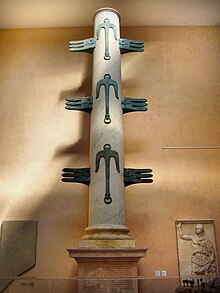Rostrata
Rostratus (masculine), rostrata (feminine) or rostratum (neuter) is a Latin adjective meaning "beaked, curved, hooked, with a crooked point, or with a curved front".[1]

In marine warfare, the term beak (rostrum) referred to the ram bows on warships, which were metal or metal-covered beams projecting from ships' bows, used to pierce enemy vessels by ramming.[2]
Roman usage
[edit]Columna rostrata (Rostral column)
After the Battle of Mylae in 260 BC during the First Punic War, a columna rostrata (a victory column), was placed in the Roman Forum in honour of Gaius Duilius. It was so called because it was adorned with the beaks (ram bows) of the captured Carthaginian vessels.[3] The columna rostrata became a favourite site for speeches.
Corona rostrata
A corona rostrata was a golden wreath, decorated with small golden prow and beak of a ship. These were awarded to commanders who were victorious in naval warfare.[4]
Modern usage
[edit]

In modern usage the adjective is used in Linnaean taxonomy to refer to a wide variety of species because of the beaked form of part of their anatomy. Examples include:
- Abrotanella rostrata is a species of cushion plant in the family Asteraceae whose white florets produce distinctively beaked cypselae (fruiting bodies).
- Bembix rostrata is a species of sand wasp native to Central Europe whose labrum is extended into a narrow beak.
- Canthigaster rostrata, known as the Caribbean sharpnose-puffer fish, lives in the Western Central Atlantic and is a puffer fish in the fish family Tetraodontidae
- Carex rostrata, known as beaked sedge or bottle sedge, is a large waterside grasslike perennial whose fruits have a beaked shape
- Helicina rostrata is a species of tropical land snail with a small beak-like projection on one side of the aperture of its shell (see image)
- Heliconia rostrata, known as Patujú or lobster claw, is a herbaceous perennial native to north west South America, with characteristic claw-shaped or beak-shaped flowers (see image)
- Yucca rostrata, the beaked yucca, is a tree-like plant belonging to the genus Yucca in southern U.S. and northern Mexico.
- Zebrasoma rostratum, known as the longnose surgeonfish or black tang, is a marine reef tang in the fish family Acanthuridae. It is so called because of its protruding snout.[5]
See also
[edit]References
[edit]- ^ Charlton T. Lewis (1890). "An Elementary Latin Dictionary". Retrieved 2009-03-27.
- ^ "Nautical Terms For The Model Ship Builder" (PDF). Model Ship Builder. 11 January 2007. Archived from the original (PDF) on 2008-07-04. Retrieved 2009-03-29.
- ^ "rostratus". Словари и энциклопедии на Академике. Retrieved 2009-03-27.
- ^ Catherine McMullen (December 2000). "Crowns and Laurels". Retrieved 2009-03-27.
- ^ "Zebrasoma rostratum - Longnose surgeonfish". FishBase. 2009. Retrieved 2009-03-29.
External links
[edit]- Image of the Columna Rostrata of C. Duilius taken from A Dictionary of Greek and Roman Antiquities. William Smith, LLD. William Wayte. G. E. Marindin. Albemarle Street, London. John Murray. 1890
